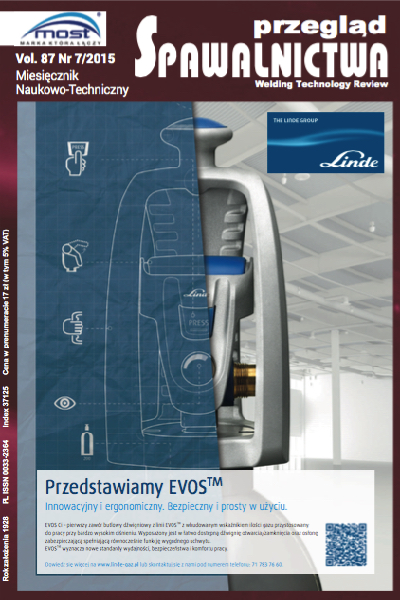Rodzaje cięcie laserowego
Main Article Content
Abstract
Cięcie laserowe jest najpopularniejszą techniką cięcia termicznego stosowanego w przemyśle. W celu uzyskania oczekiwanej jakości cięcia istotny jest prawidłowy dobór parametrów lasera i rodzaju ciecia do danego materiału poddawanego obróbce. W pracy zawarto charakterystykę podstawowych rodzajów cięcia laserowego oraz możliwości ich zastosowania do poszczególnych grup materiałów
Kind of laser cutting processes
Abstract
The laser cutting is the most popular thermal cutting technique used in the industry. In order to obtain the desired quality of cut the correct choice of laser parameters and the type of cut to the material to be treated is very important. Therefore, the paper contains the characteristics of the main types of laser and their applicability to particular groups of materials.
Downloads
Article Details
Creative Commons CC BY 4.0 https://creativecommons.org/licenses/by/4.0/
Welding Technology Review (WTR) articles are published open access under a CC BY licence (Creative Commons Attribution 4.0 International licence). The CC BY licence is the most open licence available and considered the industry 'gold standard' for open access; it is also preferred by many funders. This licence allows readers to copy and redistribute the material in any medium or format, and to alter, transform, or build upon the material, including for commercial use, providing the original author is credited.
References
Houldcroft P.: Gas-jet laser cutting. British Welding Journal, August 1967, s. 443.
Steen W. M.: Laser Material Processing, 3rd ed. 2003, Springer Verlag, London.
Chars L. Caristan: Laser Cutting Guide for Manufacturing, 2004, SME, AFFT, Dearborn, Michigan.
Ion J.C.: Laser Processing of Engineering Materials: Principles, Procedure and Industrial Application. Elsevier Butterwort- Heinemann, 2005.
Klimpel A.: Technologie laserowe. Wyd. Pol. Śląskiej, 2012.
Karatas C., Keles O., Uslan I., Usta Y.: Laser cutting of steel sheets: Influence of workpiece thickness and beam waist position on kerf size and stria formation. Journal of Materials Processing Technology, no. 172, 2006, 22-29.
Mahrle A., Bartels F. and Beyer E.: Theoretical aspects of the processefficiency in laser beam cutting with fiber lasers. Proc. 27th Int. Congress on Applications of Lasers and Electro Optics, ICALEO 2008 (October 20-23), Temecula, California, USA, 2006, 703-712.
Abdel Ghany K., Newishy M.: Cutting of 1.2 mm thick austenitic stainless steel sheet using pulsed and CW Nd:YAG laser. Journal of Materials Processing Technology, no. 168 (2005), 438-447.
Thawari G., Sarin Sundar J.K., Sundararajan G., Joshi S.V.: Influence of process parameters during pulsed Nd:YAG laser cutting of nickel-base superalloys. Journal of Materials Processing Technology, no. 170, 2005, 229-239.
Al-Mashikhi S.O., Powell J., Kaplan A.F.H., Voisey K.T.: An explanation of ‘striation free cutting of mild steel by fibre laser. Proceedings of the Fifth International WLT-Conference on Lasers in Manufacturing 2009, Munich, June 2009.
Klimpel A.: Technologia spawania i cięcia metali, Wydawnictwa Naukowo-Techniczne, Warszawa 1999
Banasik M.: Lasery molekularne CO2 w zastosowaniach spawalniczych, Przegląd Spawalnictwa (Nr 9/2000)
Zowczak W.: Laserowa obróbka ubytkowa, materiały konferencyjne, Warszawa 2003
Powell J. CO2 Laser Cutting, 1998 Springer
